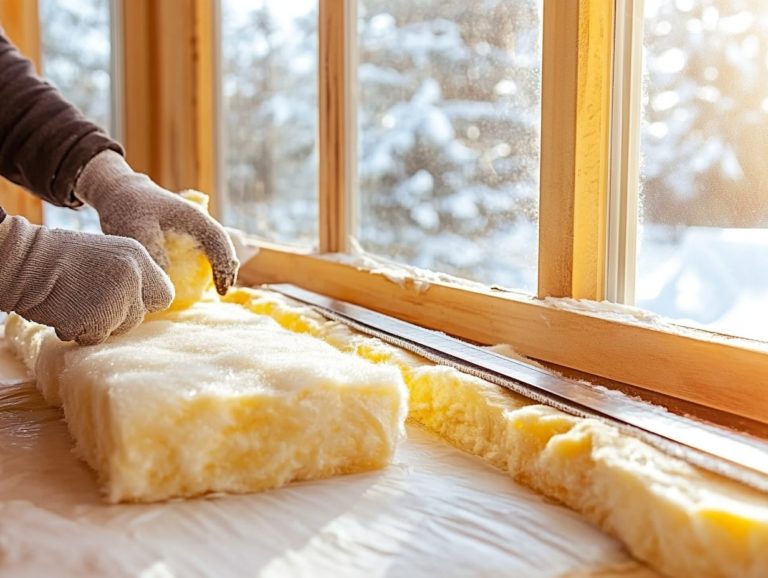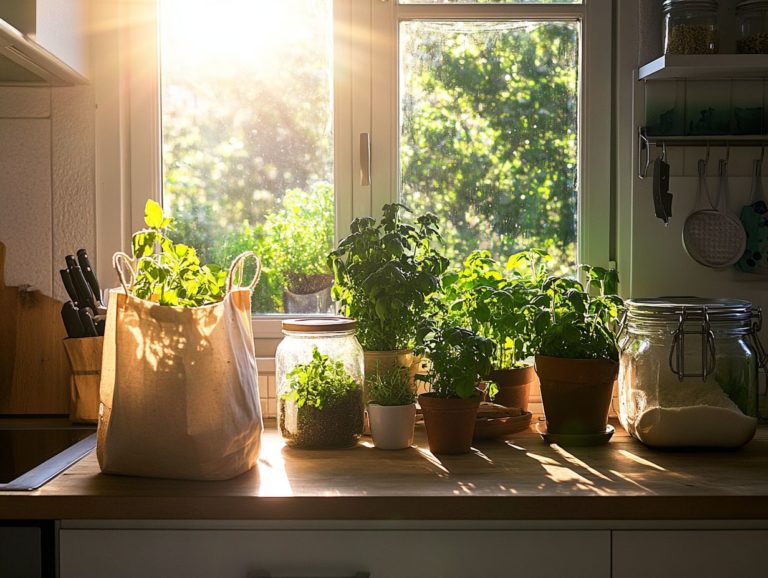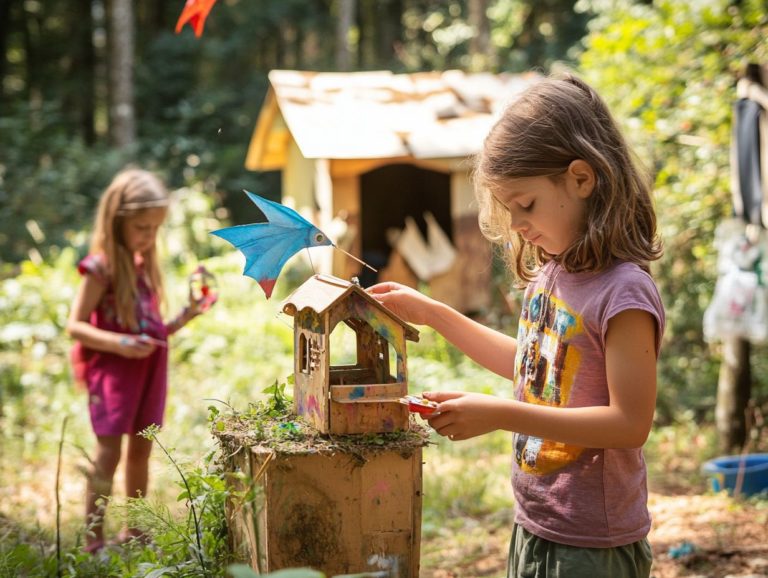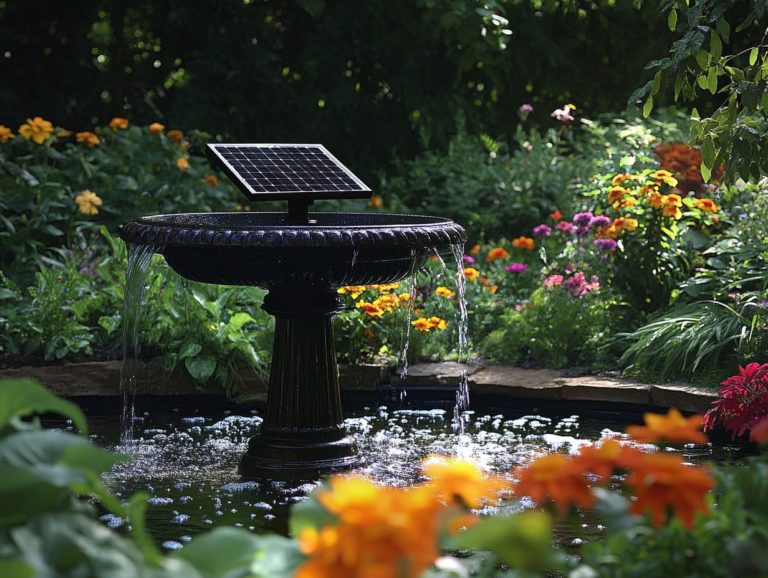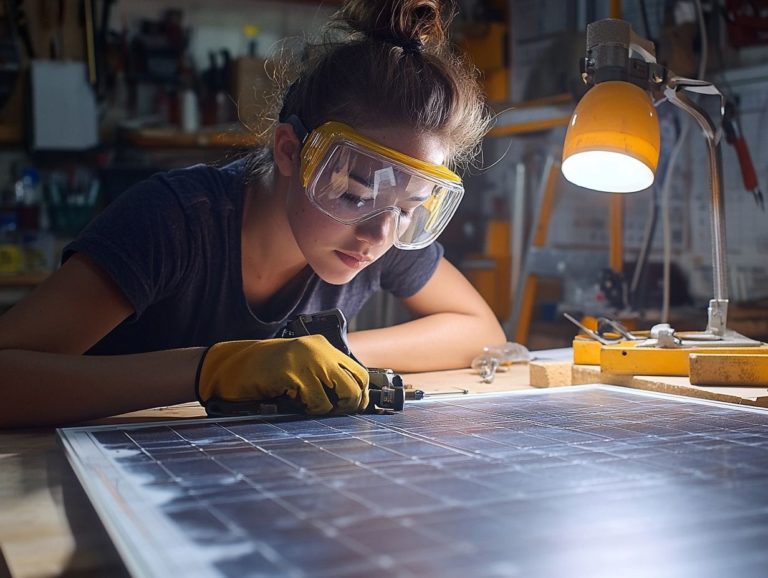10 Cool DIY Projects to Reduce Energy Bills
In a world where energy costs keep climbing, discovering ways to save money while reducing your carbon footprint is more important than ever for the American family.
This article offers you ten DIY projects designed to boost your home’s energy efficiency and home improvement, enabling you to take control of your energy consumption.
From creating your own solar panels to harnessing natural lighting solutions, these DIY projects are not only practical and budget-friendly, but also cater to a range of skill levels.
Jump in and discover how you can make impactful changes that benefit your wallet and the environment!
Contents
- Key Takeaways:
- 1. Make Your Own Solar Panels
- 2. Install a Programmable Thermostat
- 3. Create a Rainwater Collection System
- 4. Use Energy-Efficient Light Bulbs
- 5. Build a Solar Water Heater
- 6. Install Weather Stripping
- 7. Make Your Own Compost Bin
- 8. Utilize Natural Lighting
- 9. Create a DIY Wind Turbine
- 10. Insulate Your Attic
- How Can These Projects Help Reduce Energy Bills?
- Frequently Asked Questions
- 1. What are some easy DIY projects to reduce energy bills?
- 2. How can I use solar power to reduce my energy bills?
- 3. Are there any simple DIY projects to conserve water and lower my utility costs?
- 4. Can I make my own energy-efficient curtains?
- 5. How can I reduce my energy usage in the kitchen?
- 6. Are there any DIY projects for outdoor spaces that can help lower energy bills?
Key Takeaways:

1. Make Your Own Solar Panels
Creating your own solar panels can be an incredibly rewarding and sustainable home improvement project. It allows you to harness solar energy while significantly reducing your dependence on traditional energy sources, promoting energy efficiency, and contributing to environmental conservation efforts championed by the U.S. Energy Department and the Department of Energy.
One of the standout benefits of utilizing solar energy is the potential for substantial savings on your electricity bills. You could save a lot on your electricity bills, which can provide a significant return on investment over time. To embark on this project, you’ll need essential materials like solar cells, a sturdy backing board, and appropriate wiring.
This process is straightforward and accessible, even for beginners. Start by laying out the cells in a grid pattern, connect them to form a series circuit, and then securely mount them on the backing. With step-by-step instructions at your fingertips, you’ll find the process easy to follow.
Consider using energy-efficient upgrades, such as insulation blankets, to save even more energy.
Embracing solar energy not only gives you the power financially, but also paves the way for an eco-friendly lifestyle, helping to reduce your carbon footprint and promoting the use of renewable resources.
2. Install a Programmable Thermostat
Optimize temperature control with a programmable thermostat to better manage your HVAC system.
Installing a programmable thermostat is a transformative upgrade that can elevate your home’s energy efficiency. It allows for precise temperature control, ensuring your HVAC system runs only when necessary. This leads to significantly lower energy bills and a more comfortable home.
By automating your heating and cooling schedules to align with your daily routines, you can unlock remarkable energy savings studies indicate potential reductions of up to 20% in heating and cooling costs. Combine this with HVAC maintenance for optimal performance.
The installation process is straightforward: just turn off the power, remove the old thermostat, and follow the clear instructions to connect the new device to your existing wiring.
To truly optimize your settings, consider programming lower temperatures at night or during hours when no one is home. Just remember: adjusting the thermostat too frequently can lead to unnecessary energy consumption. These simple tweaks not only reduce your energy usage but also contribute to a more eco-friendly household.
Ready to take control of your energy bills? Start your first DIY project today!
3. Create a Rainwater Collection System
Creating a rainwater collection system allows you to conserve water while embracing eco-friendly solutions for both gardening and household needs. This practice contributes to a more sustainable lifestyle and helps reduce the environmental impact of your water usage.
By utilizing rain barrels or cisterns, you can effectively capture and store precipitation. This allows you to harness a valuable resource that would otherwise go to waste. These barrels come in various sizes and can be easily positioned under downspouts to create a seamless collection method.
Incorporating filtration techniques, such as mesh screens or sediment filters, ensures that the water remains clean and safe for purposes like irrigation or even flushing toilets. This approach not only promotes a more responsible method of getting water but also leads to significant savings on your utility bills. It s an attractive option that benefits both the planet and your home.
4. Use Energy-Efficient Light Bulbs
Consider compact fluorescent options for even more energy-efficient lighting.
Switching to energy-efficient light bulbs, like Compact Fluorescent Lamps (CFLs) or Light Emitting Diodes (LEDs), is a straightforward yet powerful way to cut down on electrical usage, promote energy savings, and lessen your home’s environmental footprint. This change not only benefits your energy bills but also aligns with ENERGY STAR recommendations.
While both types of bulbs are crafted to be more eco-friendly than traditional incandescent ones, they each have unique advantages regarding lifespan and energy consumption. CFLs typically last between 7,000 and 15,000 hours, whereas LEDs shine brightly for an impressive 15,000 to 50,000 hours. This remarkable longevity means you can relish fewer replacements and reduced maintenance costs over time.
By opting for these modern lighting solutions, you can experience significant reductions in your energy bills. LEDs, in particular, can use up to 80% less electricity compared to their incandescent counterparts, making them the perfect choice for both budget-savvy individuals and those committed to sustainability.
5. Build a Solar Water Heater
Energy-efficient appliances and appliance upgrades can complement the use of a solar water heater.
Building a solar water heater is not just a project; it’s an exciting DIY endeavor that transforms your home’s energy efficiency. You’re opting for a sustainable solution to heat water while significantly slashing those energy bills and making a positive impact on the environment. To enhance your energy-saving efforts, consider exploring the top 7 energy-saving tips for homeowners.
As you embark on this journey, careful planning is essential. Start by selecting the right materials, such as solar panels, copper tubing, and insulation. Choose the right tank size based on your household needs, as this greatly influences overall efficiency.
By utilizing the strength of the sun, you can expect substantial energy savings over time. Not only will you enjoy the comfort of hot water, but you ll also contribute to a lower carbon footprint in a smart, resource-conscious way. For additional benefits, consider replacing old, inefficient water heaters with energy-efficient models.
6. Install Weather Stripping
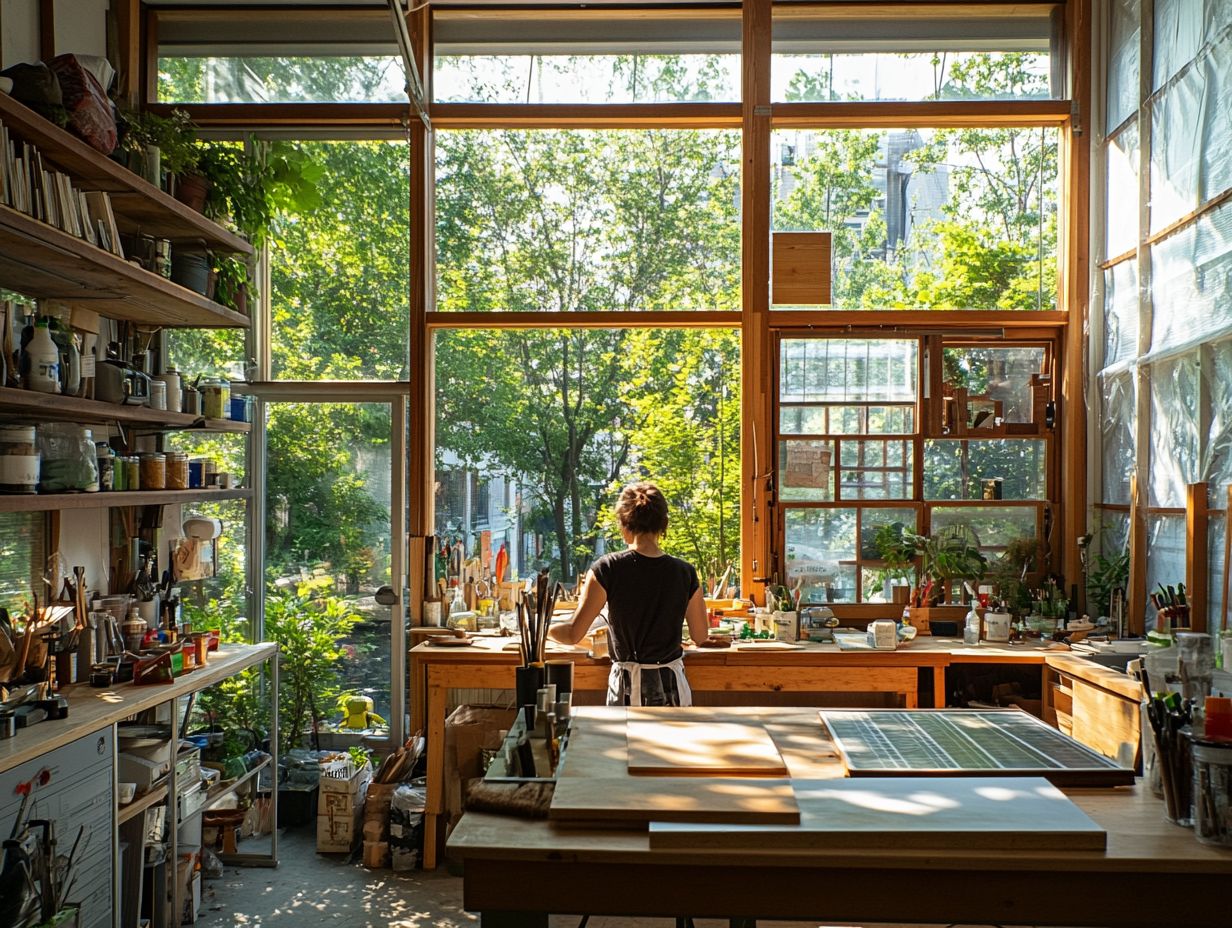
Installing weather stripping around your doors and windows is a crucial step in preventing drafts, sealing air leaks, and significantly enhancing your home s energy efficiency. This simple upgrade translates to lower energy bills and a more comfortable living space. Combine this with air sealing for maximum efficiency.
You have a variety of materials at your disposal, including foam, felt, V-seal, and rubber, allowing you to select the option that best fits your needs and budget. Foam tape is particularly effective for those irregular gaps, thanks to its flexibility, while rubber strips provide the durability and longevity that stand the test of time.
Proper installation is key; it requires careful measurement of gaps and precise application of the material to ensure a snug fit. When done right, weather stripping can have a remarkable impact on your energy consumption. It helps your home retain heating or cooling, leading to significant savings on utility bills over time and fostering a more sustainable lifestyle.
Get started on these upgrades today for a more efficient home!
7. Make Your Own Compost Bin
Consider using faux stone panels to create an aesthetically pleasing compost bin.
Creating your own compost bin is a simple, eco-friendly solution that transforms organic waste into healthy soil. This process enhances environmental sustainability while nurturing a healthier garden and landscape.
With readily available materials such as wooden pallets, wire mesh, or even plastic bins, you can effortlessly construct a functional compost system right in your backyard. Begin by selecting a location that boasts good drainage and ample sunlight both essential for composting.
Gather kitchen scraps like fruit peels, vegetable trimmings, and coffee grounds, along with yard waste like grass clippings and leaves.
Layer these materials thoughtfully to promote decomposition. Remember to turn the pile regularly to keep it well-aerated, which means allowing air to circulate. This easy and impactful step is a must for anyone looking to make a difference!
Composting is a great way to live eco-friendly. It not only reduces landfill waste but also enriches your soil, promoting vibrant plant life and attracting beneficial organisms.
8. Utilize Natural Lighting
Incorporate energy-efficient curtains to complement your natural lighting strategy.
Utilizing natural lighting in your home design elevates its aesthetic appeal and significantly enhances energy efficiency. By reducing reliance on artificial lighting, you can enjoy lower energy bills and a reduced environmental impact.
By strategically positioning your windows, incorporating skylights, and selecting light-reflective surfaces, you can effectively maximize daylighting. These thoughtful design choices create a welcoming atmosphere and promote well-being, making your spaces feel more open and vibrant.
An abundance of natural light has been shown to boost mood and productivity, especially beneficial in workspaces. With increased daylight, you will often find a reduced need for heating and cooling systems during the day, leading to a more sustainable living environment and contributing to overall energy savings.
9. Create a DIY Wind Turbine
Evaluating your home energy profile can help identify the best places to use wind turbines.
Creating a DIY wind turbine is an exciting project that allows you to harness renewable energy and generate clean electricity. This home improvement not only promotes energy efficiency but also contributes to significant energy savings over time.
As you embark on this journey, it’s essential to grasp the core components. You need the rotor blades that capture wind energy, the generator that converts that energy into usable electricity, and the tower that elevates the turbine for optimal wind capture.
Understanding the principles of wind energy is crucial. It transforms the kinetic energy of moving air into mechanical energy, paving the way for electricity production and significant energy savings.
By incorporating wind power into your energy strategy, you can reduce your dependence on traditional energy sources like fossil fuels, fostering a more sustainable and eco-friendly lifestyle.
10. Insulate Your Attic
Insulating your attic is essential for achieving optimal energy efficiency. It prevents heat loss in winter while keeping your home pleasantly cooler in summer. This can lead to significant reductions in energy bills and enhance HVAC performance by easing the burden on those energy-hungry systems.
You have various insulation materials to choose from, including fiberglass, foam board, and spray foam. Each offers distinct advantages based on your climate and specific home needs.
When considering installation, ensure the insulation is applied evenly and without gaps to maximize its effectiveness. Adding insulation blankets can provide an extra layer of efficiency.
Proper ventilation is vital alongside insulation for preventing moisture buildup, which can lead to mold and structural problems. Air sealing can help prevent air leaks, improving overall energy efficiency.
By prioritizing high-quality attic insulation, you enhance comfort throughout your home and significantly boost energy efficiency, resulting in substantial savings over time. Start your insulation project today!
How Can These Projects Help Reduce Energy Bills?
Implementing energy-efficient upgrades through various DIY projects can lead to substantial reductions in your energy bills. These improvements optimize your energy usage and contribute to a more sustainable home environment!
For instance, imagine saving up to 30% on your energy bills by installing programmable thermostats or LED lighting! Studies indicate that households utilizing these technologies can see significant savings annually. To explore more energy-saving strategies, check out these 5 ways to reduce energy waste at home. A case study in California revealed that residents who undertook simple insulation projects saw their heating bills drop by approximately 15%, resulting in substantial financial savings over time.
These specific projects not only enhance your comfort but also promote environmentally conscious practices that collectively reduce demand on energy resources. This highlights how small changes can lead to meaningful financial benefits, allowing you to enjoy a more efficient and cost-effective living space. For renters, exploring energy efficiency solutions can be particularly advantageous. Moreover, these eco-friendly solutions contribute to reducing your environmental impact.
What Materials Are Needed for These Projects?

The materials you’ll need for these DIY projects can vary, but they often include essentials such as:
- Insulation materials
- CFL or LED bulbs
- Weather stripping
- Components for renewable energy systems, like solar panels and wind turbines
- Energy-efficient appliances
Opting for the right products can significantly elevate the energy efficiency of your projects. Insulation materials, for instance, can be easily sourced from your local home improvement store or online retailers that specialize in green building materials.
When selecting CFL or LED bulbs, aim for those with Energy Star certification, as they meet rigorous efficiency standards. Whether you choose compact fluorescent or LED bulbs, both options offer substantial energy savings. Weather stripping is readily available at hardware stores, where you’ll encounter various types, such as adhesive-backed foam or V-seal. Choosing the right type will depend on the specific application in your home, such as window weatherstripping to prevent air leaks.
For renewable energy components, take the time to research reputable suppliers who offer quality solar panels and wind turbine kits. Look for those that provide detailed specifications and installation guides. Reading customer reviews can also offer valuable insights into performance and durability, ensuring you make informed decisions. Consider adding smart home technology like programmable thermostats and smart power strips to enhance overall energy efficiency!
What Are the Steps Involved in Each Project?
Each DIY project you undertake involves a series of carefully planned steps designed to enhance energy efficiency. Start with careful planning and gathering of materials, then move through installation and maintenance practices for optimal performance. Adding faux stone panels can also improve your home’s insulation and energy efficiency.
To set yourself up for success, take the time to assess your current energy consumption. Pinpoint areas ripe for improvement! This might entail conducting an energy audit, which is an assessment of how much energy your home uses. This reveals where energy is slipping through the cracks and provides valuable insights into potential changes you could implement.
Next, compile a comprehensive list of the materials and tools you ll need, while factoring in local prices and availability. Once you have everything on hand, you can dive into the installation process, diligently following the instructions to ensure maximum effectiveness.
Don t forget that maintaining your project is crucial! Regular check-ins on performance will guarantee that the energy savings you achieved endure long after the initial work is finished.
How Much Money Can Be Saved from These Projects?
Imagine saving $400 to $700 each year by investing in energy-efficient projects! The money you can save from these projects can vary widely, with estimates indicating that you could reduce your annual energy bills by as much as 30% or more, depending on the scope and effectiveness of the project.
Statistics show that households investing in energy efficiency upgrades typically enjoy savings ranging from $400 to $700 each year. These enhancements lead to significant financial savings and boost property values.
For instance, a homeowner in the Midwest recently shared their experience, noting a drop in utility costs from $200 to $140 monthly after upgrading their insulation and installing energy-efficient windows. Case studies from various cities reveal that similar projects can yield impressive reductions in energy consumption, resulting in long-term financial advantages and fostering a sustainable lifestyle for families. To learn more about such initiatives, check out maximizing energy efficiency. These projects can also qualify for energy credits, enhancing financial benefits.
What Are the Long-Term Benefits of These Projects?
The long-term benefits of your energy-efficient projects reach far beyond immediate savings; they create a wider impact that positively affects the environment and boosts your property value. For example, replacing appliances with energy-efficient models those that use less energy while performing the same tasks can significantly lower electrical usage and utility costs.
As you invest in energy efficiency, you’ll relish the delight of reduced utility bills and play a vital role in nurturing a healthier planet by lowering your carbon footprint. Over the years, this proactive approach cultivates a sustainable living environment that elevates the desirability of your property. For immediate impact, consider these 5 ways to improve your home’s efficiency today. Energy-efficient upgrades can also increase your home’s resale value and marketability.
Today s homebuyers are increasingly attracted to eco-friendly homes, translating into higher resale values and enhanced marketability. Energy-efficient lighting, such as CFL bulbs or LED bulbs, can make a home more appealing to environmentally conscious buyers.
These enhancements enrich your quality of life and instill a sense of community pride, making your neighborhood more appealing to new families and businesses alike. Projects like air sealing, draft prevention, and proper HVAC maintenance contribute to a more efficient and comfortable living environment.
Are These Projects Suitable for All Homes?
While many DIY projects aimed at boosting energy efficiency are generally suitable for various types of homes, assessing your unique home characteristics and local climate conditions is essential to determine the feasibility and effectiveness of each project. Conducting an energy audit can provide valuable insights into your home energy profile, helping you identify the most impactful changes.
This evaluation process includes considering factors like the age of your property. Older homes might possess historical features or outdated insulation, which can significantly influence the performance of certain upgrades. If you re considering new constructions, factor in modern building codes and design efficiencies that enhance energy performance. Additionally, consider the benefits of air transfer systems and energy-efficient heating systems for comprehensive energy conservation.
Understanding the local climate is crucial; for instance, homes in colder regions will likely benefit more from robust insulation and energy-efficient heating solutions, while properties in warmer climates might prioritize effective ventilation and cooling systems. By carefully analyzing these elements, you can discover how to make your home more energy efficient and make informed decisions tailored specifically to your situation.
Frequently Asked Questions
1. What are some easy DIY projects to reduce energy bills?

Some easy DIY projects to reduce energy bills include:
- Installing weatherstripping
- Using LED light bulbs
- Adding insulation to your home
- Considering draft blockers
- Using energy-efficient curtains
- Installing window insulation kits to prevent air leaks
These simple upgrades can significantly improve your home’s energy efficiency.
Don t wait! Start your energy efficiency upgrades today to enjoy immediate savings and long-term benefits.
2. How can I use solar power to reduce my energy bills?
Solar power can significantly cut your energy bills. Install solar panels on your roof or use solar-powered outdoor lights to make the most of it.
Using smart power strips can optimize energy usage and reduce costs even further.
3. Are there any simple DIY projects to conserve water and lower my utility costs?
Absolutely! You can install low-flow showerheads and faucets, fix leaks in your plumbing, and set up a rain barrel for your garden.
Also, consider water-saving showerheads and efficient laundry tips to conserve more water and reduce costs.
4. Can I make my own energy-efficient curtains?
Yes, you can create energy-efficient curtains with heavy fabrics like velvet or wool. Adding a thermal lining helps block heat and cold effectively.
For better insulation, use window weatherstripping and window caulk to prevent air leaks.
5. How can I reduce my energy usage in the kitchen?
Start saving energy today by using energy-efficient appliances and air-drying dishes instead of using the dishwasher. Cooking with lids on pots and pans also retains heat, reducing cooking time and energy usage.
6. Are there any DIY projects for outdoor spaces that can help lower energy bills?
Absolutely! You can create a shade structure with reflective materials to block the sun. Installing motion-sensor lights and using landscaping for natural shade will help improve your home’s insulation.
Consider adding faux stone panels like those from GenStone to enhance both aesthetics and energy efficiency.

